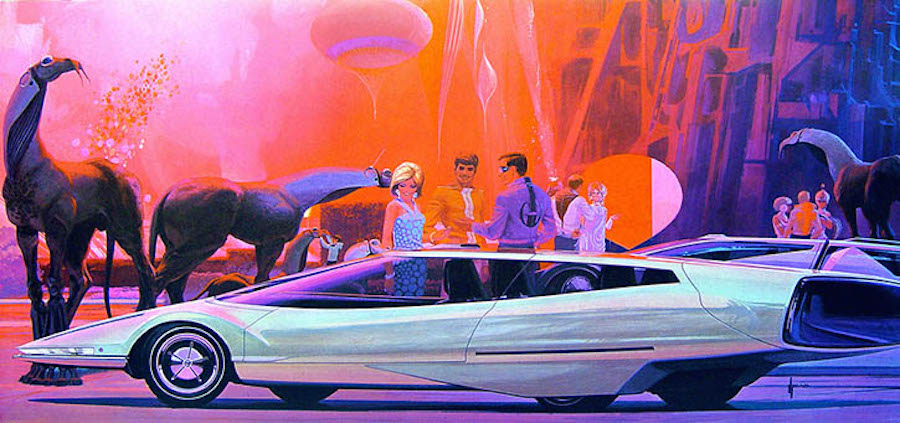
After the horrors of the world wars, a vibrant utopian vision emerged in America. The acceleration of science and technology during the war combined with the consumer frenzy prompted by the post-war economic boom and found its way into the realm of domesticity, so that middle and upper class Americans could watch the first moon landing from their colour televisions. The splitting of the atom provided a cleaner, more modern source of energy and weapons capable of apocalyptic destruction. With the dismantling of the Nazi war machine, America found itself in conflict with the Soviet Union and tensions began to rise.
The Space Age started with the launch of Sputnik, an artificial sattelite built by the Soviet Union. This sparked a series of rapid technological advancements in a competition between the US and the Soviet Union. These missions provided inspiration for architecture, automotive design, fashion and furniture that included synthetic materials and biomorphic shapes reminiscent of the portrayal of space in popular culture, including tv shows such as The Jetsons, which aired from 1962 to 1963. This style was so distinctive, that it is what we think about when we refer to retro-futurism, an artistic movement that depicts stylistic combinations of old-fashioned retro styles with futuristic technology.
This cultural movement characterized how the future was being viewed in the past, with a pristine vision of the future. Artists imagined a world with flying cars, laser guns, floating cities with monumental skyscrapers, time travel and the conquest of the galaxy. Retro futurism was part utopian and part dystopian exploring themes of potential tension between the past and the future that was created through various media such as television, film, science-fiction, design, and architecture. Retro futuristic designs were heavily inspired by the advent of space exploration of the 1950s/60s. For more than half a century people's visual perception of the future were dominated by glossy plastics, smooth curves and popping neon colors like in the sets of Stanley Kubrick's “2001: Space Odyssey”.
The influence of 1950s and 60s utopian vision extended far beyond art and design. Much of space age culture centred around the ideals of the nuclear family, consisting of a breadwinning father married to a homemaker mother and their resulting children. This created a polarized dichotomy, where men went to the extremes of exploration, travelling into space and women were tied to the home and their children, prior to the advent of reliable contraceptives and safe abortions. These 'family values', which shunned homosexuality and affirmed traditional gender roles would continue to haunt conservative politics indefinitely. Because this was seductively beneficial to the cisgendered, heterosexual male, this dynamic remains normalized, although it is being countered by the feminist movement.
Possibly the finest film of Stanley Kubrick’s illustrious career, 2001: A Space Odyssey is considered to be one of, if not the best, science fiction film of all time. A revolutionary work that was way ahead of its time, 2001 remains a cinematic enigma that examines technology, evolution and human identity, keeping audiences guessing since the release of the film in 1968.

Betty Willis, Welcome to Fabulous Las Vegas Nevada (sign), 1959
Retrofuturist architecture was often called the “Googie” style from the 1940s to the 70s. This term was first coined by the Googie Coffee Shop (1949) designed by John Lautner in Los Angeles, California. This style is commonly found on signage, as seen on the iconic Vegas sign, restaurants/diners, motels and gas stations. The Googie style includes defining elements such as neon, glass and plastic materials and the “starburst” figure. Much of retrofuturist architecture had a sci-fi influence with space-like elements and lots of suggestion of movement, color and light.

Syd Mead, Untitled, n.d.
2D art and film during the retrofuturist period often revolved around a more modern depiction of the world and universe. This art became a hybrid of sci-fi and reality to create new, fantastical environments and creatures. Mead is an American retro futurist illustrator born in 1933 that worked on famous films such as Blade Runner, Tron, Star Trek and other sci-fi based work. Much of his work focuses on futuristic atmospheres and environment building. He is also known for his illustrations of futuristic vehicles and robotics.
Hana-Barbera, The Jetsons, 1962
The Jetson's was a popular cartoon that provided a comical version of the future and featured aliens, holograms and plenty of gizmos and gadgets. Set 100 years in the future, this cartoon supported the popular idea of the colonization of space for human consumption. Because of the boom in consumer culture, and mass pollution of the environment, this future promotes the idea of space as a safe haven for our species to expand into, once the earth has been consumed.